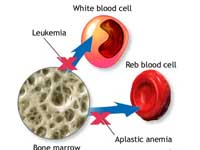Are there Advantages of Bone Marrow Transplant for Patients?
Leukemia patients who have blood stem cell transplants survive just as long on average as those who undergo the more invasive procedure of having a bone marrow transplant, scientists said on Monday.

But patients with acute forms the blood cancer appear to do better if they have bone marrow as opposed to blood stem cell transplants, the scientists said, suggesting that for some the benefit of the complex treatment is greater in the long run.
Bone marrow transplants involve the collection of stem cells from the bone marrow -- a complicated procedure in which the patient must have a general anesthetic and surgery.
In peripheral blood stem cell transplantation (PBSCT), stem cells are collected from blood, avoiding some of the complications of bone marrow collection.
Researchers from the Charite Medicine University in Berlin, Germany, looked at survival rates in 329 patients from 42 transplant centres in 13 European countries, Israel and Australia who had received PBSCT or bone marrow transplants.
They found that rates of survival after 10 years were similar, at 49.1 percent for blood stem cell recipients and 56.5 percent for bone marrow transplant recipients.
But they found "notable differences in survival in patients with acute leukemia's," they said in the study published in the Lancet Oncology medical journal.
After 10 years, patients with acute lymphoblastic leukemia (ALL) had a survival probability of 28.3 percent after bone marrow transplant compared with 13.0 percent after PBSCT. In patients with acute myeloid leukemia (AML) the probabilities were 62.3 percent for bone marrow and 47.1 percent for blood stem cell transplants.
"Different patient groups might still benefit from transplantation with bone marrow," the researchers concluded.
Reuters has contributed to the report.
Subscribe to Pravda.Ru Telegram channel, Facebook, RSS!




